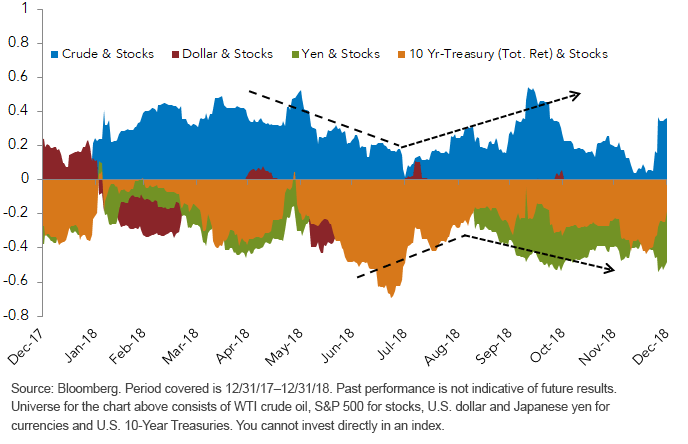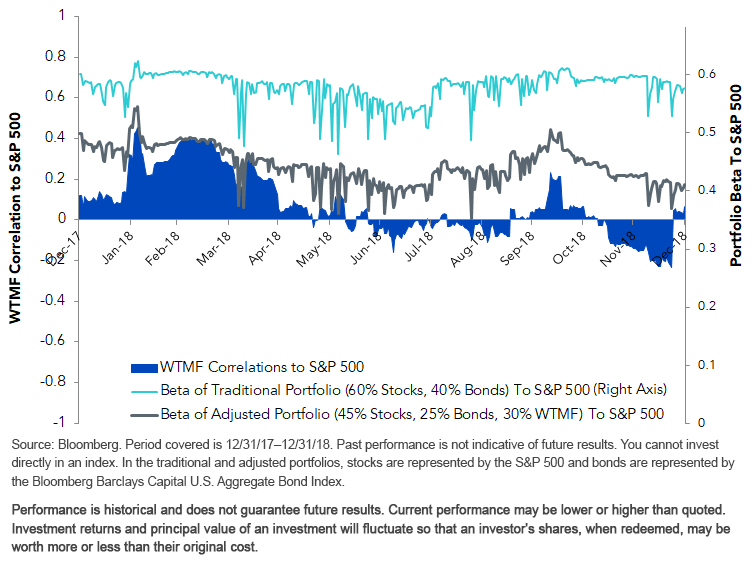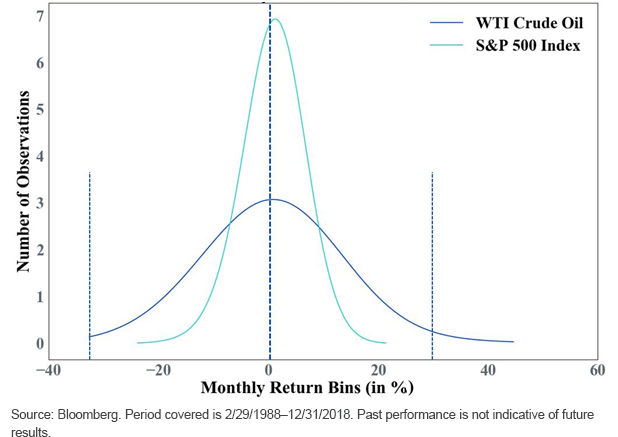How to Manage Rising Volatility


Markets are hard, and experienced investors usually do not confuse lack of volatility with stability. Markets are inherently volatile, which can lurk behind the prevailing calm.
The bigger question is: How should an investor deal with rising volatility?
One way of reducing systematic risk is by decorrelating your portfolio to major asset classes by using a multiasset long/short exposure.
Below, I highlight a multiasset long-short strategy that aims to reduce beta, with a key exception.
Spiking Correlations in Times of Stress
Last year was a wild ride for stocks. Big swings meant cross-asset correlations got stronger.
Rising Correlations Post Brexit Fears
60-Day Rolling Asset Correlations

Two patterns are obvious:
- Cross-asset correlations were high last year.
- After a period of cooling off, there was jump in stock correlations across these four major assets.
Jittery markets usually increase correlations across assets. That makes it hard for investors to remain diversified.
Multiasset Long-Short Solution to Lower Portfolio Beta
The WisdomTree Managed Futures Strategy Fund (WTMF) seeks to provide total returns in volatile markets, uncorrelated to the averages. It does this by going both long and short in various commodities, interest rates and currencies.
The chart below shows WTMF in 2018 consistently had near-zero correlations (blue area, left axis), even during the volatile fourth quarter, when most asset classes correlated.
WTMF's Diversification Lowering Beta of a Traditional 60/40 Approach

For definitions of terms in the chart please visit our glossary.
Please click here for standardized performance of WTMF.
There are two dozen futures contracts that the underlying index of WTMF monitors every month across commodities, interest rates and the energy complex. It then bets long or short in each, based on its set of signals. The exception is energy. This is a key differentiator of our managed futures approach compared with a lot of our competitors. In WTMF, energy is always either long or neutral—it doesn’t short energy contracts, even if the signal says so. It does this because energy has significant geopolitical risk, which is uncertain and hard to predict.
Beyond just economic intuition, this tendency of the asset class to melt up is evident in its skewed distribution of its monthly returns, which have an asymmetric long right tail.
Monthly Return Distribution

The chart above compares the monthly distribution of S&P 500 and oil futures returns. Compared with the S&P 500, which has a relatively symmetric distribution, oil has a long right tail, implying a tendency of that asset class to melt up rather than melt down. Thus, to mitigate any potential losses due to an unexpected positive run up in oil, our managed futures fund, WTMF, avoids shorting oil even if trend signals are bearish; it simply goes net neutral in such a scenario. The same is true across other future contracts such as natural gas, gasoline, heating oil, etc., in the energy complex, which also shows similar melt-up tendencies as demonstrated by oil above.
Conclusion
Our managed futures strategy, WTMF, can be a great way to help reduce portfolio beta. It uses a quantitative, rules-based strategy giving market neutral allocation that reduces overall correlations and has built-in checks and balances to reduce risk within individual asset classes.
We think WTMF could be one answer to the age-old search by investors for an investment solution that offers total returns with lower volatility and higher diversification, especially during stressful times in the markets.
Important Risks Related to this Article
Diversification does not eliminate the risk of experiencing investment losses.
There are risks associated with investing, including possible loss of principal. An investment in this Fund is speculative, involves a substantial degree of risk and should not constitute an investor’s entire portfolio. One of the risks associated with the Fund is the complexity of the different factors that contribute to the Fund’s performance, as well as its correlation (or noncorrelation) to other asset classes. These factors include use of long and short positions in commodity futures contracts, currency forward contracts, swaps and other derivatives. Derivatives can be volatile and may be less liquid than other securities and more sensitive to the effects of varied economic conditions. The Fund should not be used as a proxy for taking long-only (or short-only) positions in commodities or currencies. The Fund could lose significant value during periods when long-only indexes rise (or short-only) indexes decline. The Fund’s investment objective is based on historic price trends. There can be no assurance that such trends will be reflected in future market movements. The Fund generally does not make intramonth adjustments and therefore is subject to substantial losses if the market moves against the Fund’s established positions on an intramonth basis. In markets without sustained price trends or markets that quickly reverse or “whipsaw,” the Fund may suffer significant losses. The Fund is actively managed; thus, the ability of the Fund to achieve its objectives will depend on the effectiveness of the portfolio manager. Due to the investment strategy of this Fund, it may make higher capital gain distributions than other ETFs. Please read the Fund’s prospectus for specific details regarding the Fund’s risk profile.


